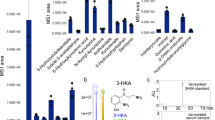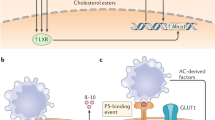Abstract
Replying to G. J. Maghzal et al. Nature 514, 10.1038/nature13844 (2014)
After our initial observation of defective tryptophan catabolism in experimental chronic granulomatous disease (CGD)1, several laboratories have been testing the indoleamine 2,3-dioxygenase (IDO1) competence of cells from CGD patients. In most instances, they found no impairment in IDO1 competence in terms of tryptophan catabolic activity in vitro by polymorphonuclear leukocytes and monocyte-derived dendritic cells2,3, leading to the conclusion that there is no obvious defect in the production of kynurenine (the first by-product of tryptophan degradation)—hence in the IDO1-dependent mechanism of tolerogenesis as a whole in human CGD. In the accompanying Comment4, Maghzal et al. report that tryptophan catabolism is unaffected in chronic granulomatous disease, again by measurements of kynurenine production.
Similar content being viewed by others
Main
However, a number of studies have now been providing evidence that the assay is not sufficiently informative as to the local versus systemic functioning of the IDO1 mechanism, particularly on considering the pleiotropic effects of IDO1 in vivo5,6. While we stand by our original observations in CGD mice with lethal pulmonary aspergillosis1, it should be noted that, in all of the experimental models tested so far, lack of IDO1 competence does not result, per se, in spontaneous inflammatory pathology. Yet, the functional defect becomes obvious when mice not competent for IDO1 function are challenged with an inflammatory noxa recognized more usually by Toll-like receptors7. Additionally, a number of potential factors have now been identified that further substantiate the concept that a global defect in IDO1 functioning underlies the severe chronic inflammation in CGD, among which are local accumulation of peroxynitrites8 (which compromise IFN-γ signalling necessary for IDO1 induction9) and IL-6 (ref. 8) (which promotes IDO1 proteasomal degradation10), lack of IDO1-dependent neutrophil apoptosis11, loss of IDO1-driven non-canonical NF-κB activation (otherwise resulting in downregulation of proinflammatory cytokines, and upregulation of tolerogenic TGF-β), and probably defective IDO1 signalling activity12.
Thus the problem is not whether cells from CGD patients and mice equally display defective tryptophan catabolism in vitro. Rather, when contextualized to the current knowledge, that is a matter of appreciation that the IDO1 mechanism, and the multiple downstream regulatory responses over which it presides—including control of the over-reactive responses to TLR signalling—are globally compromised. The situation—that is, elevated rather than suppressed circulating kynurenine and/or in vitro production in CGD patients3—may be similar to that of septic patients who display high levels of circulating kynurenine in the face of defective overall IDO1 functioning13.
Substantial differences might occur between human and experimental CGD, and p47phox-deficient mice with infection-related acute inflammatory lung injury may well be an extreme condition. Such as they are, those mice provide a sound proof-of-principle in their being a prototypic model of a specific condition, exemplifying how in experimental CGD the IDO1 mechanism of disease tolerance13 is severely compromised at sites where it would mostly be beneficial to control local inflammatory reactions. The very nature of granulation formation could be but one of the multiple phenotypic manifestations of defective IDO1 functioning in infection-related pathology14. This Reply has been written on behalf of the entire original author list1, most of the original authors are no longer working with us or on the specific subject.
References
Romani, L. et al. Defective tryptophan catabolism underlies inflammation in mouse chronic granulomatous disease. Nature 451, 211–215 (2008)
Jürgens, B., Fuchs, D., Reichenbach, J. & Heitger, A. Intact indoleamine 2,3-dioxygenase activity in human chronic granulomatous disease. Clin. Immunol. 137, 1–4 (2010)
De Ravin, S. S. et al. Tryptophan/kynurenine metabolism in human leukocytes is independent of superoxide and is fully maintained in chronic granulomatous disease. Blood 116, 1755–1760 (2010)
Maghzal, G. J. et al. Tryptophan catabolism is unaffected in chronic granulomatous disease. Nature 514, http://dx.doi.org/10.1038/nature13844 (2014)
Fallarino, F. et al. The combined effects of tryptophan starvation and tryptophan catabolites down-regulate T cell receptor ζ -chain and induce a regulatory phenotype in naive T cells. J. Immunol. 176, 6752–6761 (2006)
Fallarino, F., Grohmann, U. & Puccetti, P. Indoleamine 2,3-dioxygenase: from catalyst to signaling function. Eur. J. Immunol. 42, 1932–1937 (2012)
Volpi, C., Mondanelli, G., Puccetti, P. & Grohmann, U. TLRs and tryptophan metabolism at the crossroad of immunoregulatory pathways. Immunometabolism 1, 28–50 (2014)
Rodrigues-Sousa, T. et al. Deficient production of reactive oxygen species leads to severe chronic DSS-induced colitis in Ncf1/p47phox-mutant mice. PLoS ONE 9, e97532 (2014)
Grohmann, U. et al. A defect in tryptophan catabolism impairs tolerance in nonobese diabetic mice. J. Exp. Med. 198, 153–160 (2003)
Orabona, C. et al. SOCS3 drives proteasomal degradation of indoleamine 2,3-dioxygenase (IDO) and antagonizes IDO-dependent tolerogenesis. Proc. Natl Acad. Sci. USA 105, 20828–20833 (2008)
Röhm, M. et al. NADPH oxidase promotes neutrophil extracellular trap formation in pulmonary aspergillosis. Infect. Immun. 82, 1766–1777 (2014)
Pallotta, M. T. et al. Indoleamine 2,3-dioxygenase is a signaling protein in long-term tolerance by dendritic cells. Nature Immunol. 12, 870–878 (2011)
Bessede, A. et al. Aryl hydrocarbon receptor control of a disease tolerance defence pathway. Nature 511, 184–190 (2014)
Zelante, T., Fallarino, F., Bistoni, F., Puccetti, P. & Romani, L. Indoleamine 2,3-dioxygenase in infection: the paradox of an evasive strategy that benefits the host. Microbes Infect. 11, 133–141 (2009)
Author information
Authors and Affiliations
Corresponding author
Rights and permissions
About this article
Cite this article
Romani, L., Puccetti, P. Romani & Puccetti reply. Nature 514, E18 (2014). https://doi.org/10.1038/nature13845
Published:
Issue Date:
DOI: https://doi.org/10.1038/nature13845
Comments
By submitting a comment you agree to abide by our Terms and Community Guidelines. If you find something abusive or that does not comply with our terms or guidelines please flag it as inappropriate.



